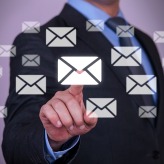When it comes to marketing, it can be tough to determine the most effective strategies. There are so many different ways you can try to lure customers to your brand: a free ebook, email marketing and press releases are few strategies often used. But how do you know what’s most effective? It all comes down […]
 When it comes to marketing, it can be tough to determine the most effective strategies. There are so many different ways you can try to lure customers to your brand: a free ebook, email marketing and press releases are few strategies often used. But how do you know what’s most effective? It all comes down to looking at data to see what works best. We’ve done some legwork for you to show how this old school marketing tactic is still influencing customers as much today as it did decades ago.
When it comes to marketing, it can be tough to determine the most effective strategies. There are so many different ways you can try to lure customers to your brand: a free ebook, email marketing and press releases are few strategies often used. But how do you know what’s most effective? It all comes down to looking at data to see what works best. We’ve done some legwork for you to show how this old school marketing tactic is still influencing customers as much today as it did decades ago.
What is one thing every consumer has in common? They all love to save money. This is why the marketing technique of offering coupons is still as effective today as it was decades ago. Shocked? Don’t believe this is true? Well, let’s explore some statistics.
A recent report by Valassis, a large marketing firm that serves clients across the globe, provided some enlightening information on the effectiveness of coupons. Here’s what they discovered in terms of how coupons influence consumers.
- 82% of all consumers are more likely to buy from a brand they wouldn’t normally because of a coupon
- 85% are influenced to try a new product because of a coupon
- 84% are more likely to switch brands because of the weekly specials on offer
- 24% choose to shop at another brand’s store over their preferred because of better advertised bargains
While this recent report goes a long way to revealing the benefits of coupons, how do they compare to another common marketing offer used today: free information products?
The appeal of coupons over information products
According to one marketing firm based in Waterford, Connecticut, a coupon was chosen 9 out of 10 times over an ebook when offered simultaneously. This raises an interesting question: why would a coupon be more effective than a free ebook or other information product? Let’s look at some common psychology triggers at play here.Broad appeal - simply put, coupons have mass appeal. While information products are likely to be seen as more valuable to those with a higher education, a coupon can appeal to all income brackets - from the very wealthy to the very poor.
Instant value - to gain results from an information product requires a time investment and action. For example, if a customer receives a free 30 page ebook that explains how to get the best discounts on electronic equipment, he or she needs to read the book and then take action (and possibly create a plan) to gain the rewards of that time investment. Many consumers would rather spend their time doing something else, but a coupon on the other hand offers immediate value. Simply hand it over to the service provider, and you save money instantly. What’s not to love about that?
Uniqueness - the online marketplace is flooded with free information products. While they’re still an effective tool to gain a prospect’s email address, far fewer businesses offer coupons on their website, especially in the small business sector. By offering a coupon, you provide a free offer that immediately separates you from the pack.
The point here is that just because a marketing tool is popular doesn't mean it’s the most effective. This is why we encourage you to review data and statistics before implementing any marketing technique in your business. It can save you a whole lot of time and also make your business stand out.
Want more valuable business information that can help you connect better with your customers? Curious to learn how IT can help collect data more easily? Call us today to find out more.

 There are a lot of web-based email platforms in the marketplace. Many come and go, but there’s a reason Gmail has crossed the 1 billion monthly active user milestone and is still standing strong as one of the world’s most popular web-based email clients. It’s extremely easy to use and is always up-to-date and secure, courtesy of Google. But if you’re just using Gmail for sending and receiving emails, you’re really missing out on some of its nifty features that allow you to manage your email more effectively. Here are some tips to make the most of Gmail.
There are a lot of web-based email platforms in the marketplace. Many come and go, but there’s a reason Gmail has crossed the 1 billion monthly active user milestone and is still standing strong as one of the world’s most popular web-based email clients. It’s extremely easy to use and is always up-to-date and secure, courtesy of Google. But if you’re just using Gmail for sending and receiving emails, you’re really missing out on some of its nifty features that allow you to manage your email more effectively. Here are some tips to make the most of Gmail.
 It’s the middle of the month and you’re waiting to meet a colleague outside a restaurant. As you wait, you idly browse the web and check emails, and then suddenly you’re hit with the notification you dread most. Your Android phone’s data is almost out. Questions race through your mind...how will I make it through the last couple of weeks with limited data? Should I buy more? Should I just suck it up and use the slower connection once it’s gone? Let’s face it, these are all questions you want to avoid. And here’s how you can do just that with some tips to save data on your Android phone.
It’s the middle of the month and you’re waiting to meet a colleague outside a restaurant. As you wait, you idly browse the web and check emails, and then suddenly you’re hit with the notification you dread most. Your Android phone’s data is almost out. Questions race through your mind...how will I make it through the last couple of weeks with limited data? Should I buy more? Should I just suck it up and use the slower connection once it’s gone? Let’s face it, these are all questions you want to avoid. And here’s how you can do just that with some tips to save data on your Android phone.
 Hackers come in all shapes and sizes. From kids trying to gain notoriety on the Internet to political groups trying to send a message, the motives for a cyber attack vary widely. So how can you protect yourself? It all starts with getting to know your enemy a little better. Here’s a profile of four different types of hackers.
Hackers come in all shapes and sizes. From kids trying to gain notoriety on the Internet to political groups trying to send a message, the motives for a cyber attack vary widely. So how can you protect yourself? It all starts with getting to know your enemy a little better. Here’s a profile of four different types of hackers.